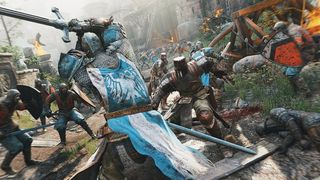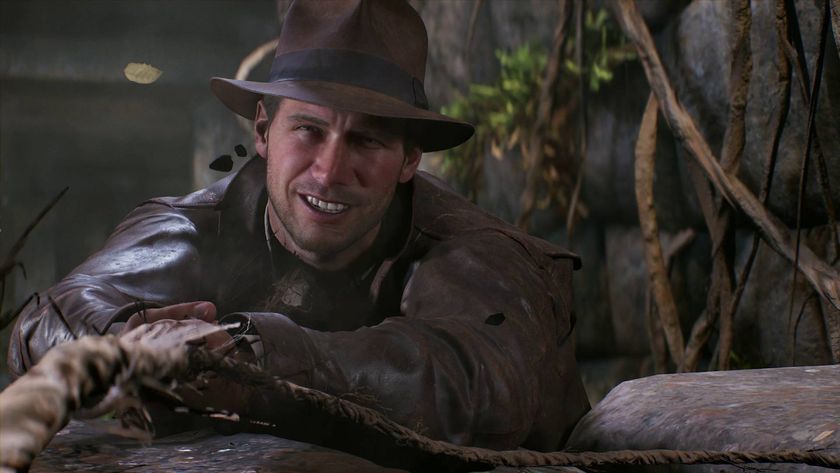For Honor - a game of war more than a decade in the making
If the art to winning a battle is biding your time, For Honor’s creative director Jason Vandenberghe should be considered the master of war. “This game has actually been in my head for about 12 years now,” he confesses to us. “I pitched it to anyone who would listen, and the answer for ten years was: ‘No, no, no, no, no and no, and furthermore no. And also no.’”
A student of Russian martial arts (“it’s a study of how European knights actually fought with longswords and short swords”), Vandenberghe came up with the game’s concept after leaving his dojo one night. “I was just walking down the beach and thinking about the patterns that we would use and I got to thinking about game controllers. Suddenly, I was like: ‘Wait a minute! There’s another way to arrange a controller for fighting [games] so that it would feel like it does when I pick up a weapon and fight in real life.’”

And after a decade of perseverance, For Honor’s creator finally won the toughest fight of all: getting the green light. “Finally I pitched it to Yannis Mallat, head of Ubisoft Montreal, and instead of ‘no’, he introduced me to the team that had worked on Naruto. I brought them my idea, and they were like: ‘Wow, that’s really cool. It’s kinda broken in some ways, but let’s see if we can fix it?’”
Ubisoft isn’t a stranger to the b-word in recent times (we’re looking at you, Creed), but early code already feels refined and polished. That’s because what was broken in the initial concept has now been tempered into a tight, rounded system called the Art Of Battle. “I had some ideas about combos,” Vandenberghe recalls, “and a combat tutorial that was pretty weird. We had more stances for a while, and I also had a fascination with gestures. None of that crap worked! We discovered that through rapid iteration: we built about 400 prototypes in our first 18 months because we knew we were exploring uncharted territory.”

What’s left at the end of that process is a very simple fighting system with few inputs. R1 is light attack, R2 is heavy attack, holding L2 triggers the Guard stance and holding the right stick up, left or right moves your weapon in that direction. You attack from the direction your sword’s held and defend strikes by lifting your weapon towards an incoming blow.
There’s more depth buried away in this system – Square will break enemy guard stances while attacking into an incoming strike in the right way will parry the move – but just sticking with the basics opens up a surprising amount of depth as players try desperately to out-think each other.
As you rush around the map to reach and hold various points in Dominion mode, you’ll cut through swathes of AI fighters with single swings of your weapon and get opportunities to ‘lock on’ to other players for more tactical fights. But it’s more than possible to have two or more players lock onto the same foe if teams aren’t coordinating efforts and planning attacks. Foolhardy solo excursions will result in death.
Sign up to the 12DOVE Newsletter
Weekly digests, tales from the communities you love, and more

Picking the right faction is also a factor in your success. “Each plays in thematically appropriate ways,” Vandenberghe explains. “Knights are more defensive and tough, while Vikings are more aggressive. It’s more than just skins and animations; it’s going to come down to mechanical differences in the way that the inputs work and some faction-specific moves.
“All three have multiple heroes, each with their own weapon, armour, style and attacks. Fundamentally, the choice in how you’re going to fight is really built around: ‘Which hero are you?’” So far Ubisoft’s just showcased the Knight’s ‘Jack-of-all-trades’ Warden and the Samurai’s Oni (fast with kunai and poison katana abilities). There’s much more to come, but even now it’s a fascinating deviation from the norm and it’s bursting with fresh ideas.
Click here for more excellent Official PlayStation Magazine articles. Or maybe you want to take advantage of some great offers on magazine subscriptions? You can find them here.
We are Play magazine, the biggest-selling,100% independent, magazine for PlayStation gamers. Founded in 2021, it's brought to you by the same team of writers, editors, and designers as the Official PlayStation Magazine, with the same deep industry access, quality of writing, and passion for all things PlayStation. Follow us for all things PS5, PS4, and PlayStation VR.













Intergalactic: The Heretic Prophet is "a game about faith and religion," which Neil Druckmann jokes will surely get less hate than The Last of Us 2

The Last of Us creator Neil Druckmann says Intergalactic: The Heretic Prophet will also be about "being lonely," as if his zombie apocalypse wasn’t isolating enough: "I really want you to be lost"





